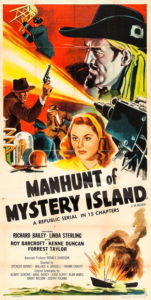
We all like a good pirate movie, don’t we? And we all love the old movie serials. So the natural question to ask is: Were there any pirate serials? You bet!
The Great Adventures of Captain Kidd was released by Columbia Pictures in 1953. And there were serials that weren’t actually pirate serials but traded freely upon the name. Universal Studios’ Pirate Treasure in 1934. The 1944 Republic serial Pirates’ Harbor. Columbia put out Pirates of the High Seas in 1950.
My favorite pirate serial that wasn’t about pirates is Manhunt of Mystery Island, a 1945 “pirate” serial. The pirates are there in name only; the chief villain dresses like a pirate. But there’s no Jolly Roger, no bounding main, no swashbuckling, no “yo ho, me hearties.” But even lacking those essentials, it is most enjoyable in its own right.
You see, there’s this guy who wants to take over the world. I know, you’ve heard this one before; but bear with me. He’s one of the four owners of Mystery Island and has a hidden lair and laboratories beneath the mansion and in the island caves. He’s perfected a “transformation machine” that allows him to change his appearance and become the spitting image of his 200-year-old pirate ancestor Captain Mephisto, as portrayed by character actor Roy Barcroft. It’s no cheap disguise. This machine actually changes the cells in his body!
Now, with such a machine a person could take over the world! Or so you would think. You could transform yourself into any world leader and take his place. Or commit crimes in the body of another person to avoid identification. But while you and I might think that the possession of such a machine would be sufficient for any self-righteous would-be world conqueror, not so for our villain. No indeed. He never even considers the possibilities of this wondrous machine in his quest for world domination. No, in order to conquer the world, he feels he needs a “radiotomic transmitter” invented by Professor William Forrest.
Captured by Mephisto
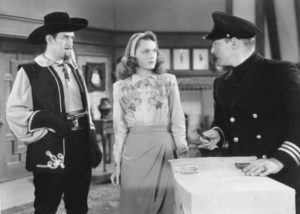
Captain Mephisto, whoever he is in real life, has kidnapped Professor Forrest and is keeping him held prisoner in his underground laboratory. He’s trying to force the professor to finish building his power transmitter so the evil captain can take control of world industry. You and I might forget the power transmitter and go with the already-perfected transformation machine. A bird in the hand, you know. But not so Captain Mephisto. He seems blissfully unaware of this alternate and simpler means to achieve his goal. He’s obsessed with obtaining Professor Forrest’s transmitter. Obsession, the mark of a serial villain.
The professor’s daughter, Claire, enlists the aid of criminologist Lance Reardon to help her track down her kidnapped father. And so to Mystery Island they sojourn, to spend the next 14 chapters fighting the evil minions of Captain Mephisto. They are invited to stay at Mansion House, co-owned by the four direct descendants of the original pirate Captain Mephisto. One of these four is the main villain who transforms himself into Captain Mephisto. But which one?
This is a pretty neat variation on the “masked villain” theme. In a number of serials, the villain is a masked character who isn’t revealed until the final chapter. The hero or heroine has a group of suspects who could all possibly be the masked villain. As the serial progresses, the group of likely suspects dwindles until the unmasking in the final chapter. This serial uses the same concept, but the villain isn’t masked; he’s transformed into Captain Mephisto!
It’s a most enjoyable serial. I found the chapter endings, the cliffhangers themselves, to be quite inventive. Not once in all 15 chapters did they use “the easy out.” When the resolution of the cliffhanger involves the hero simply jumping out of the way, I refer to that as “the easy out.” Unfortunately, it’s used all too often in serials.
The easy out
Some examples of “the easy out.” At the end of one chapter, we see our hero plunge in his car over a cliff. At the beginning of the next chapter, we see him jump out just in time. That’s “the easy out.” Or our hero’s motorboat crashes into a riverboat in a flaming explosion. But next week’s episode shows he jumped out just in time. Or our hero is run down by a car. But next week we see that he jumped out of the way just in time. Plane crash? He bails out just in time. You’ve seen it time after time in the serials. And it always leaves us feeling unsatisfied.
I’m happy to report that the screenwriters for Manhunt of Mystery Island never used “the easy out.” Not even once, in all 15 chapters! The boat explodes? It turns out it was the other boat. Claire crashes her boat onto the rocks? She really does, but luckily survives. Yes, the chapter endings are clever and their resolutions are equally honest. No “cheats” and no “easy outs!”
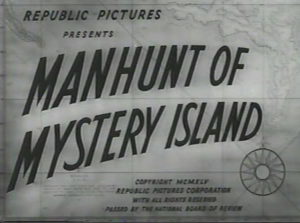
One of my favorite cliffhangers in this chapter play is the suspension bridge. This cliffhanger scene was lovingly reused by George Lucas in Indiana Jones and the Temple of Doom when Indy battled Thuggee cult members on a long suspension bridge. And of course, the bridge is hacked away at one end while Indy is in mid-bridge.
In the original 1945 version of this cliffhanger from Manhunt of Mystery Island, our hero and heroine are in the middle of the suspension bridge when Captain Mephisto cuts the ropes on one side of the cliff. They don’t simply ride it down, like in the Indiana Jones movie. I always figured that if the sudden end of such a ride wasn’t fatal, it at least would have jarred them loose from the remnants of the suspension bridge.
In the Mystery Island serial, they actually do fall away from the bridge pieces, as shown in the cliffhanger of chapter 13. And in the beginning of chapter 14, you see them fall into the gorge and land in the river far below. You see, no “easy outs” here!
The Economy Chapter
This serial has an “economy chapter.” In chapter 10, the hero and heroine discuss what they’ve done so far, and we see some flashbacks from previous episodes. Of course, this was mainly done to reduce the budget on such a long 15-chapter serial. But considering that their prime audience was 10-year-old boys with short memories, it was also advisable to recap some of the plot that they hadn’t seen for over two months. And there were certainly other boys who missed the first chapter or two, and needed catching up as well.
As another cost-saving measure, the wonderful scene where the mystery man changes into Captain Mephisto is used repeatedly in the serial. This scene shows the buzzing, sparking laboratory equipment and the “electric chair” device that performs the mysterious transformation. By my count, this particular scene was used in 12 of the 15 chapters. And it was in the serial trailer, too! But rather than being a bad thing, I’m sure that those 10-year-old boys were anxiously awaiting the chance to see Captain Mephisto’s transformation each Saturday afternoon.
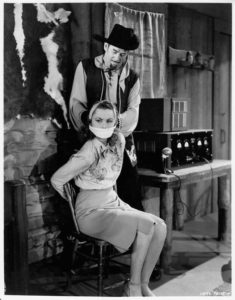
And speaking of that transformation machine, it can be used to heal! At the end of chapter 13, when Captain Mephisto cuts that suspension bridge, he receives a bullet wound in his left arm. However, in chapter 14, when he goes through the transformation machine to return to his original identity, the machine heals the bullet wound. That means our hero can’t identify the villain by means of the bullet wound. But it also means much more.
Think of the possibilities of this wonderful machine. Apparently it keeps your cellular pattern and restores it when you change from one form to another. If it can heal a bullet wound in the arm, think what else it could do. Bullet wound in the stomach? Use the transformation machine, and you’re healed! Break a bone? Use the transformation machine to fix it. Cut off a finger? Use the transformation machine, and it’s back! Why didn’t our villain exploit this amazing power? Forget the professor’s power transmitter. This transformation machine is the true path to world domination!
Shades of ‘Star Trek’!
The transformation machine reminds me of the “transporter” in the Star Trek television series. Although the transporter’s main purpose was to transport people, it was also sometimes used to heal people. The transporter kept a virtual copy of a transported individual in its pattern buffer. There were certain episodes where in order to cure a disease the individual was run through the transporter to be restored back again. It was even used to reverse aging. Are these similarities between the transformation machine and the transporter simply coincidence? Could Captain Mephisto, inventor of the transformation machine, have left his plans to be found years later by Gene Roddenberry? It gives one pause to wonder.
The last scene in the serial provides a great laugh. Not an unintentional laugh, although serials had plenty of those, too; this one was an intentional one. After 15 weeks of searching for the secret panel that led to the hidden passages of the mansion, the story has ended. Captain Mephisto is dead and Professor Forrest is free. Our hero, Lance Reardon, the professor and his daughter stand in the mansion living room, when the secret panel behind Mephisto’s painting slowly swings open.
Out from the passage steps the servant, Ruga, with a pail and mop. “I was just cleaning the passage,” he calmly remarks. Yes, he knew about it all the time. It was no secret! Our protagonists could have saved weeks worth of searching for this hidden panel if they had only thought to ask the servant! I love it!
This is one to view!

This serial is not currently available on an official studio-released DVD, and I’ve heard of no future release plans. Wanting a DVD copy, I grabbed my old Republic laserdiscs and did my own transfer to DVD. That was years ago. The serial was also released on VHS tape… also years ago. If you do a google search, you’ll find you can stream it online. I can heartily recommend watching it. You won’t regret it.
I love this serial. Lots of action. Great cliffhangers and resolutions. Great plot. And about as close to a pirate serial as you’ll ever get… without having pirates!

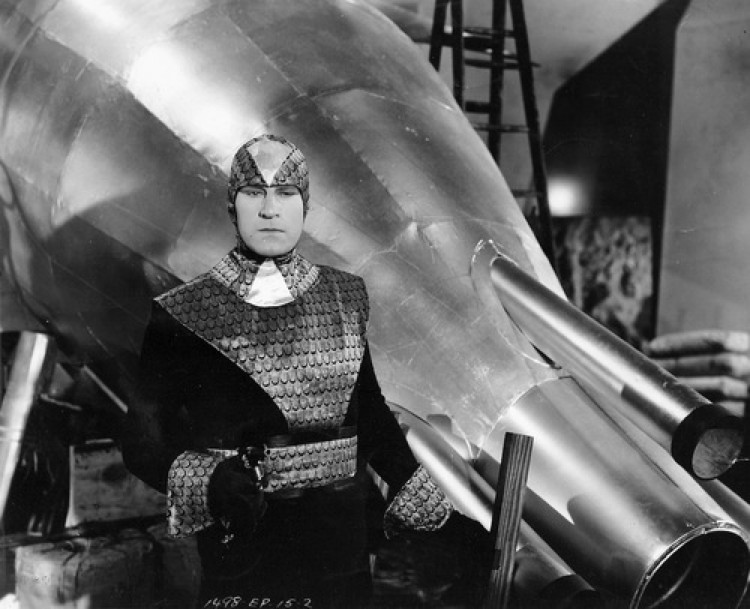
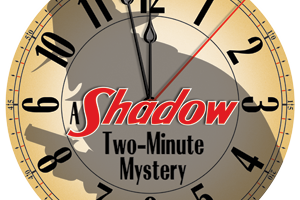
Roy Barcroft was a great actor, who deserved much more attention than he got. He finally got to play a good guy in the Spin and Marty serials on Mickey Mouse Club in the mid 1950s.
As a kid, I watched Spin and Marty faithfully, and loved his Mr. Logan character. It was only years later that I started watching serials and began to see him in a villainous light. As you say, a most unappreciated actor.
But as much as I loved the Spin and Marty serials, the Hardy Boys were even better. But that’s a whole different subject… and perhaps one for a future blog posting.
A Favorite serial.
Felt the same Star-Trek connection when I watched it. (For the umpteenth time)
Lucas sure loved to pull from these old aerials.
(Especially the Flash Gordon flick.)
A lot of serials had that element where the bad guy was one of the main characters in disguise and only revealed at the end. (I think the Caltain Marvel serial had a similar theme with the Scorpion character.)
Captain Marvel — now there’s a serial I think I’ve seen four times. And for me, that’s unheard-of. Usually once is enough. But I first saw Captain Marvel back in the 1960s on silent 8mm film. Everything was subtitled, so you’d know what people were saying. Crude, but I was hooked.
I watched it again in the 1970s on 16mm sound film. Again when it came out on VHS… then again when it was released on laserdisc.
Of course, I have Captain Marvel on DVD, now. And I think I hear it crying out to me. Yes, it might just be time to watch it again!